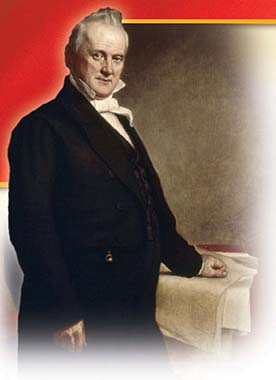SECTION 4: Lincoln, Secession, and War

◄ President Buchanan
WITNESS HISTORY  AUDIO
AUDIO
The President Falters
Outgoing President James Buchanan condemned South Carolina’s secession from the Union but was unwilling to use force to stop it. Many northerners criticized his weak response to the crisis. In an address to Congress, he seemed almost baffled that the situation had deteriorated so far:
“How easy it would be for the American people to settle the slavery question forever and to restore peace and harmony to this distracted country! … All that is necessary to accomplish the object, and all for which the slave States have ever contended, is to be let alone and permitted to manage their domestic institutions in their own way. As sovereign States, they, and they alone, are responsible before God and the world for the slavery existing among them.”
—President Buchanan, December 3, 1860
Objectives
- Compare the candidates in the election of 1860, and analyze the results.
- Analyze why southern states seceded from the Union.
- Assess the events that led to the outbreak of war.
Terms and People
- Jefferson Davis
- John C. Breckinridge
- Confederate States of America
- Crittenden Compromise
- Fort Sumter
NoteTaking
Reading Skill: Identify Causes and Effects Use a cause-and-effect chart to show the events that led to secession.
Why It Matters Despite repeated attempts at compromise, disagreement between the North and the South over the issue of slavery continued to deepen. With the election of Republican President Abraham Lincoln in 1860, the crisis came to a head. The Union of states that had been formed less than a hundred years before was about to dissolve. Section Focus Question: How did the Union finally collapse into a civil war?
The Election of 1860
John Brown’s raid and execution were still fresh in the minds of Americans as the 1860 presidential election approached. Uncertainty about Kansas—would it be a slave state or a free state?—added to the anxiety. In the North, loss of confidence in the Supreme Court resulting from the Dred Scott decision and rage about the Fugitive Slave Act’s intrusion into the states’ independence further aggravated the situation.
The issue of states’ rights was on southern minds as well. Would northern radicals conspire to eliminate slavery not only in the territories but also in the original southern states? In the spring of 1860, Mississippi senator Jefferson Davis convinced Congress to adopt resolutions restricting federal control over slavery in the territories. The resolutions also asserted that the Constitution prohibited Congress or any state from interfering with slavery in the states





